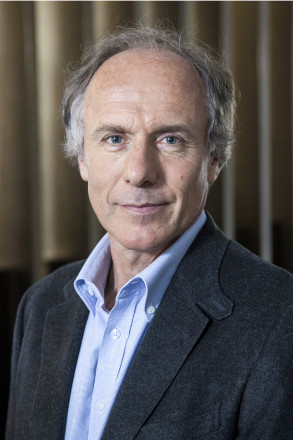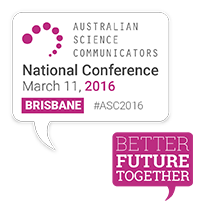Below you will find the transcript from the keynote delivered by Australia’s eighth Chief Scientist Dr Alan Finkel AO at the 2016 ASC National Conference on March 11 at the Queensland University of Technology.
To win hearts and minds
The engineer who spells
I’m a stickler for spelling and grammar. It irritates my wife, my children and my staff no end.
“Alan, you’re an engineer,” they tell me. “You’re supposed to spell like someone who’s really good with numbers but communicates in grunts.”
I tell them they’re wrong. I don’t care about language in spite of the fact that I’m an engineer. I care about language because I’m an engineer.
After all, what do engineers and scientists love best?
Systems. Structures. Algorithms. All frameworks that deliver reliable outcomes with minimum waste and maximum precision.
And what is language but the delivery vehicle for the most important raw materials of all?
Language is the freight-way of ideas. It is the optic fibre our ancestors used to communicate to their descendants. Indeed, language is the greatest civil engineering project of all time.
We needed language when we were making clothes out of bits of woolly mammoth. How much more do we need it when we are writing algorithms ‑ the clearest of logical thinking that must follow explicit rules?
The grammar of algorithms is important because the hardworking computer operating systems on which they run are completely bamboozled by the simplest of spelling or grammatical mistakes. Engineers have no choice but to care about getting it right.
We even care about split infinitives. My staff might urge me to boldly go, but on my watch, we’ll be going boldly.
The principles of good writing
Just as there are principles and forms for words and sentences, there are principles and forms for writing.
We know this because we can teach those things to robots – or, more accurately, we can program robots to learn them from us.
I’m referring, of course, to artificial intelligence, or AI.
Consider the company Automated Insights, with its software programme ‘Wordsmith’. Wordsmith takes anything you can put on a spreadsheet and turns it into an article or report. Think stock market summaries, annual reports, football re-caps, real estate reviews.
Thus far Wordsmith has created more than a billion automated articles and reports, for clients including Associated Press and Yahoo. And it’s not the outer limits of what AI can already do.
Google, for example, is working on software that writes city guides based on the billions of images tourists upload to the web. Imagine what more we could do with image recognition in future. There are 1.8 billion images posted online every day that reporters never see. What stories could AI find that we’ve never told?
Or imagine what a robot could learn about ‘speaking human’, by trawling every work in the literary canon – or every sentence ever tweeted – in every language we have ever recorded.
Could that robot ever compose the line… “I have a dream”?
They say that speechwriters to the US President are called the ‘White House ghosts’. Are we spooked by the coming army of robot ghosts?
If you’re feeling threatened, you’re possibly in the wrong room. If you’re already thinking through the consequences, then we need you.
Embracing the AI opportunity
The consequences of AI will be an opportunity for high quality science communication if we human writers meet the revolution with the qualities we celebrate in our craft.
Passion. Rigour. Flair.
I’ve got three reasons why we should be optimistic.
First – AI is not an existential threat. In fact, it’s probably the best argument I’ve ever seen for your continued existence.
Bear with me here.
Yes, AI can recognise and generate a gee-whiz, click-bait headline. And yes, it can churn out workmanlike text. If that’s your sole definition of good writing, then you’ve just been displaced.
But it’s not my definition – and I hope it’s not yours. Good writing doesn’t measure its success in eyeballs engaged but in minds inspired.
It dares us to think, with the oldest human technique of all – the story.
There’s no AI on the market that can match it – and I don’t expect to see it anytime soon.
Of course I marvel at the progress we’ve made in AI. But I marvel just as much at the limits we’re struggling to transcend. Both the achievement, and the magnitude of the challenge, tell you something about the awesome power of the human brain.
We would be a very sad sort of society if we thought we could get by without great stories and the people who tell them.
AI will do the mundane, the routine, leaving time for human journalists to create vivid word pictures and write the stories we want to read.
In that sense, AI ought to bring out the best in the humans.
Second – we’re sitting on a gold mine. A data gold mine. Scientists are making more of it every day. We’ve just got to get the gold to market.
To give you one example – a story that broke this week from the United States.
Many cynics have suspected for a long time that there’s a lot of recycling of cryptic crossword clues. But no-one has been able to gauge the scale of it, until now.
It took an engineer and a journalist to do it.
The engineer built a database of 52 thousand crosswords, dating back to the 1940s. Then he wrote a program to cross-match every single crossword, against every other crossword.
The journalist found the story in the data.
More than fifteen hundred puzzles from a major publisher were at least 75 per cent similar to previously published work.
So thinking outside the box revealed the dodgy practices inside the grids. Now, it’s spelled out – in black and white.
Further proof that scientists, engineers and journalists are the great defenders of civilisation.
Third – I believe we can adapt to the forces restructuring the mainstream media outlets.
For a long time, the gold standard in journalism was the full-time science reporter – able to assemble the ingredients and produce a masterful cake. As we know, those positions are scarce today – and those that do exist are often insecure.
The science community has responded with clever services like the Australian Science Media Centre, supplying the equivalent of cake mix to the major news desks. It helps harried journalists to deliver a substantiated product, of guaranteed relevance, to mainstream readers.
Today, however, it seems many journalists haven’t even got the time to make up a cake mix. But the hunger for good content remains.
So there are three routes they could pursue:
- One – the status quo. Take any cake you can get, from anywhere it comes, cost-free. Often, it’s a media release from an interested party – so you can’t be certain of the nutritional quality or the salmonella risk. But we know that a lot of outlets will still swallow them up and pump them out, verbatim.
- Two – the factory model. Harness AI to make the mass-produced equivalent of the Sara Lee chocolate cake. Sure, it’s a good cake. But it’s the same good cake you ate last week, and the week before. If you ate nothing else, you’d never know how great a cake can really be.
- Three – the Vera Finkel model, named in honour of my mother. Connect journalists with expert writers who can supply the home-cooked, masterful, one-of-a-kind production. Content with credibility, with style; made available to the mainstream reader.
In future, I think we’re likely to see a combination of all three.
We can wait for the first and second to lower the bar for science communication – or we can take the initiative now to adopt the Vera Finkel model. Even though it is the hardest to resource and make available at scale.
I know that this model ‑ on their initiative not mine ‑ is on the agenda for the board of the Australian Science Media Centre. I expect it will come up in the conversation today.
Let me just repeat my absolute confidence that there is a need and an opportunity for the high-quality work you want to produce. Get the business model right, and the market will respond.
Markets are made by customers, in this case our readers. It should never be forgotten that our readers are intelligent, eager to learn, and responsive to good narratives.
People want to listen
I’ve been thinking about eager, intelligent readers a great deal lately, in the wake of the announcement of the observation of gravitational waves.
If you work in science communication, you know this story. And you will know that it’s the Bermuda Triangle of communication.
Everything difficult in a science communicator’s brief is there:
- Cosmically enormous, and infinitesimally small numbers.
- Astronomy, advanced physics and cosmology, combined.
- Jargon as thick as a physicist’s beard.
- Acronyms like a toddler let loose on a plate of alphabet spaghetti.
Then there’s the small matter of the Theory of General Relativity and the distortion of the fabric of space time. With a little bit of quantum squeezing thrown in for good measure.
And yet, there it is on the front page of the New York Times. Trending on Twitter. Blowing the cat videos out of the water. Making waves of its own.
Making it easier for me to explain the business case for Big Science.
A professional skill and a critical role
Speaking of which, it’s worth pausing to remember just how influential you really are.
Governments can do many things, but they will never make us reach for things we cannot see.
It’s not government who thought of the LIGO detector for gravitational waves – it was scientists.
Just as it was journalists who explained the results, to inspire people all around the world to dream of the futures that might now unfold.
Of course you can’t do it alone – but you are the critical connecting link. So we need you today, more than ever.
My challenge to you is simply this: help Australians to appreciate science deeply, not just to note it.
The love of science means respect for intellect. The thirst for opportunity. And the determination to put in the effort.
So continue to be determined to make chocolate cakes that will win the hearts and minds of Australians.
Thank you.


